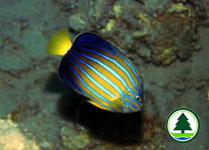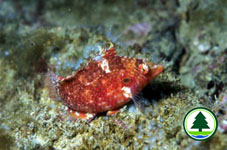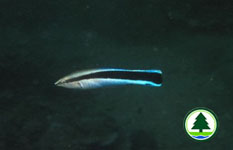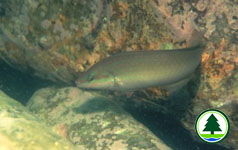|
Hong Kong Corals & the Associated Marine Life
Phylum Chordata includes both vertebrates and invertebrates, comprising three sub-phyla: Urochordata (Sea squirts & Salps), Cephalochordata and Vertebrata (vertebrates)
|
Sea Squirts (Sub-phylum Urochordata, Class Ascidiacea)
|
|
Sea squirts are the invertebrates related most closely to vertebrates, though they are most often confused with sponges, the simplest living group of multicellular organisms. Some sea squirts are entirely pelagic while those commonly found in coral areas are benthic, in both solitary and colonial forms.
Both solitary and colonial sea squirts have a body wall with two openings, the oral and cloacal siphons. Long bundles of muscle fibres in the body wall can contract the body quickly to produce a fine stream of water coming in and going out the siphons. Within the body wall are the branchial sac for gas exchange, food-gathering structures, stomach, circulatory system, gonads and other internal organs.
|
Reef Fish (Sub-phylum Vertebrata)
|
|
There are four major classes of fishes alive today, the lampreys (Cephalaspidomorphi), the hagfish (Pteraspidomorphi), the cartilagenous fish (Chondrichthyes) and the bony fish (Osteichthyes). Only the cartilagenous fish (sharks and rays) and the bony fish (most other fish) inhabit reef. There are about 350 species of shark and 500 rays worldwide. Among the estimated 23,000 species of bony fish, around 13,000 are marine.
Reef fish are those that spend part or all of their lives on or close to areas of hard substrata. Most "reefs" in Hong Kong are rocky although there are a number of small coral communities, particularly in eastern waters. They provide food and shelter to the fish that inhabit them.
The biodiversity of reef fish in Hong Kong is relatively high, being greater than that of Hawaii for instance. It is similar to other locations in the South China Sea such as Hainan Island. Hong Kong has an interesting mix of tropical species that are distributed widely throughout the Indo-Pacific and temperate species which mostly occur from Hong Kong north to Japan and Korea. No reef fish are known to be endemic to Hong Kong.
Although the diversity of local reef fish is high, some of them such as the surgeon and triggerfish that are normally common on coral reefs are rare now. This is likely because local conditions are not suitable for them, or there are few larvae of these species settling onto local reefs. Reef fish are heavily dependent on the continued survival of hard corals. Having healthy coral communities in local waters is essential for the continual survival of the reef fish.
|
 |
|
Doederlein's Cardinalfish
Apogon doederleini (Apogonidae)
|
|
|
There are 4-5 narrow brownish strips on the whitish to pinkish body. Juveniles occur in schools, often found between coral heads or large rock crevices. This species is common in local waters.
|
| |
|
 |
|
Broadbanded Cardinalfish
Apogon fasciatus (Apogonidae)
|
|
|
Cardinalfish are nocturnal, remaining close to shelter and in schools by day, and dispersing to feed at night. They are also interesting as the males incubate the eggs in their mouths after fertilisation until the larvae hatch. Broadbanded cardinalfish inhabit areas of silt and sand near reefs, often in large schools.
|
| |
|
 |
|
Longfin Grouper
Epinephelus quoyanus (Serranidae)
|
|
 |
Blue-blotch Butterfly Fish
Chaetodon plebeius (Chaetodontidae) |
|
|
This species of butterfly fish was recently first recorded from local waters. It is quite rare, inhabiting rich areas of hard coral as it feeds mainly on live polyps of Acropora corals. Hong Kong is probably close to the northern limit for this tropical species along the coast of mainland China.
|
| |
|
 |
Mirror Butterfly Fish
Chaetodon speculum (Chaetodontidae) |
|
|
This species looks similar to C. plebeius, but it doesn't have a black spot at the tail base. It is common in Port Shelter.
|
| |
|
 |
Brownband Butterfly Fish
Chaetodon modestus
(Chaetodontidae) |
|
|
It is a distinctive fish, with two broad brownish-yellow bars on each side of the silvery-white body. This species is one of the most abundant butterfly fish in Hong Kong. Though this butterfly fish is a deep water species in other regions, it can be found in local shallow boulder areas.
|
| |
|
 |
Threadfin Butterfly Fish
Chaetodon auriga (Chaetodontidae) |
|
|
This species is unmistakable with the diagonal bands on the body and the black spot at the posterior margin. It is widespread and moderately abundant below waters of 3 m in depth.
|
| |
|
 |
Lined Butterfly Fish
Chaetodon lineolatus
(Chaetodontidae) |
|
|
This species has many fine black vertical lines covering the body. The dorsal, caudal and anal fins are bright yellow. It is moderately abundant in coral areas of Port Shelter.
|
| |
|
 |
Blackbacked Butterfly Fish
Chaetodon melannotus (Chaetodontidae) |
|
|
It has diagonal black lines on both sides of the white body and a broad black near the dorsal fin. This fish was found at Bluff Island , probably occurring from Lamma Island to Ping Chau.
|
| |
|
 |
Eightband Butterfly Fish
Chaetodon octofasciatus
(Chaetodontidae) |
|
|
It is a juvenile hiding among the branches of stony coral Acropora. It is distinctive with the 8 vertical bars on the yellow body. This species is moderately abundant in areas of Acropora corals.
|
| |
|
 |
Hong Kong Butterfly Fish
Chaetodon wiebeli (Chaetodontidae) |
|
 |
Long-fin Bannerfish
Heniochus acuminatus (Chaetodontidae) |
|
| |
|
 |
| Chinese Demoiselle Neopomacentrus bankieri (Pomacentridae) |
|
|
This is the most abundant fish inhabiting coral communities after some of the gobies. It was described as a new species from a specimen collected in Hong Kong in the early 1800s. The new species was named after R.A. Bankier, a surgeon in the British Navy, who collected the specimen. Although the Chinese demoiselle is known from other regions, it only seems to be common here.
|
| |
|
 |
Bengal Sergeant
Abudefduf bengalensis (Pomacentridae) |
|
|
On the sides of its yellow body, seven bands can be found, which are distinctly narrower than the spaces between them. This species is common in shallow boulder and coral areas.
|
| |
|
 |
Yellowtail Clownfish
Amphiprion clarkii (Pomacentridae) |
|
|
Its body colour is highly variable throughout its range, from orange , brown to black. The three white bars on the head and body is distinctive. This species is common and always found associated with the sea anemone Entacmaea quadricolor.
|
|
|





















